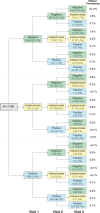Longitudinal patterns in indeterminate HIV rapid antibody test results: a population-based, prospective cohort study
- PMID: 38189332
- PMCID: PMC10845946
- DOI: 10.1128/spectrum.03253-23
Longitudinal patterns in indeterminate HIV rapid antibody test results: a population-based, prospective cohort study
Abstract
Rapid HIV tests are critical to HIV surveillance and universal testing and treatment programs. We assessed longitudinal patterns in indeterminate HIV rapid test results in an African population-based cohort. Prospective HIV rapid antibody test results, defined by two parallel rapid tests, among participants aged 15-49 years from three survey rounds of the Rakai Community Cohort Study, Uganda, from 2013 to 2018, were assessed. An indeterminate result was defined as any weak positive result or when one test was negative and the other was positive. A total of 31,405 participants contributed 54,459 person-visits, with 15,713 participants contributing multiple visits and 7,351 participants contributing 3 visits. The prevalence of indeterminate results was 2.7% (1,490/54,469). Of the participants with multiple visits who initially tested indeterminate (n = 591), 40.4% were negative, 18.6% were positive, and 41.0% were indeterminate at the subsequent visit. Of the participants with two consecutive indeterminate results who had a third visit (n = 67), 20.9% were negative, 9.0% were positive, and 70.2% remained indeterminate. Compared to a prior negative result, a prior indeterminate result was strongly associated with a subsequent indeterminate result [adjusted prevalence ratio, 23.0 (95% CI = 20.0-26.5)]. Compared to men, women were more likely to test indeterminate than negative [adjusted odds ratio, 2.3 (95% CI = 2.0-2.6)]. Indeterminate rapid HIV test results are highly correlated within an individual and 0.6% of the population persistently tested indeterminate over the study period. A substantial fraction of people with an indeterminate result subsequently tested HIV positive at the next visit, underscoring the importance of follow-up HIV testing protocols.IMPORTANCERapid HIV tests are a critical tool for expanding HIV testing and treatment to end the HIV epidemic. The interpretation and management of indeterminate rapid HIV test results pose a unique challenge for connecting all people living with HIV to the necessary care and treatment. Indeterminate rapid HIV test results are characterized by any weak positive result or discordant results (when one test is negative and the other is positive). We systematically tested all participants of a Ugandan population-based, longitudinal cohort study regardless of prior test results or HIV status to quantify longitudinal patterns in rapid HIV test results. We found that a substantial fraction (>15%) of participants with indeterminate rapid test results subsequently tested positive upon follow-up testing at the next visit. Our findings demonstrate the importance of follow-up HIV testing protocols for indeterminate rapid HIV test results.
Keywords: HIV diagnostics; indeterminate; point of care testing; rapid test; serology.
Conflict of interest statement
The authors declare no conflict of interest.
Figures
References
-
- World Health Organization . 2021. Consolidated guidelines on HIV prevention, testing, treatment, service delivery and monitoring: recommendations for a public health approach - PubMed
-
- World health organization . 2010. Delivering HIV test results and messages for re-testing and counselling in adults - PubMed
-
- World Health Organization . 2015. HIV assays: laboratory performance and other operational characteristics: rapid diagnostic tests (combined detection of HIV-1/2 antibodies and discriminatory detection of HIV-1 and HIV-2 antibodies)
MeSH terms
Grants and funding
- U01 AI100031/AI/NIAID NIH HHS/United States
- U01 AI075115/AI/NIAID NIH HHS/United States
- P30 AI094189/AI/NIAID NIH HHS/United States
- K01 AI125086/AI/NIAID NIH HHS/United States
- R01 AI110324/AI/NIAID NIH HHS/United States
- R01 AI102939/AI/NIAID NIH HHS/United States
- T32 AI102623/AI/NIAID NIH HHS/United States
- R01 HD050180/HD/NICHD NIH HHS/United States
- R01 MH107275/MH/NIMH NIH HHS/United States
- F31 DA054849/DA/NIDA NIH HHS/United States
- R01 AI143333/AI/NIAID NIH HHS/United States
- R01 HD070769/HD/NICHD NIH HHS/United States
- UM1 AI068613/AI/NIAID NIH HHS/United States
LinkOut - more resources
Full Text Sources
Medical


